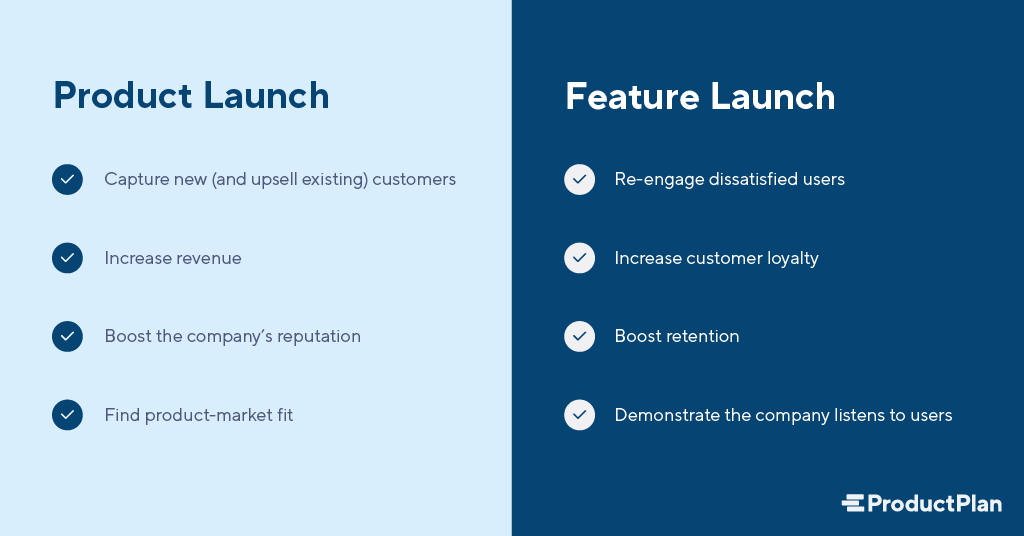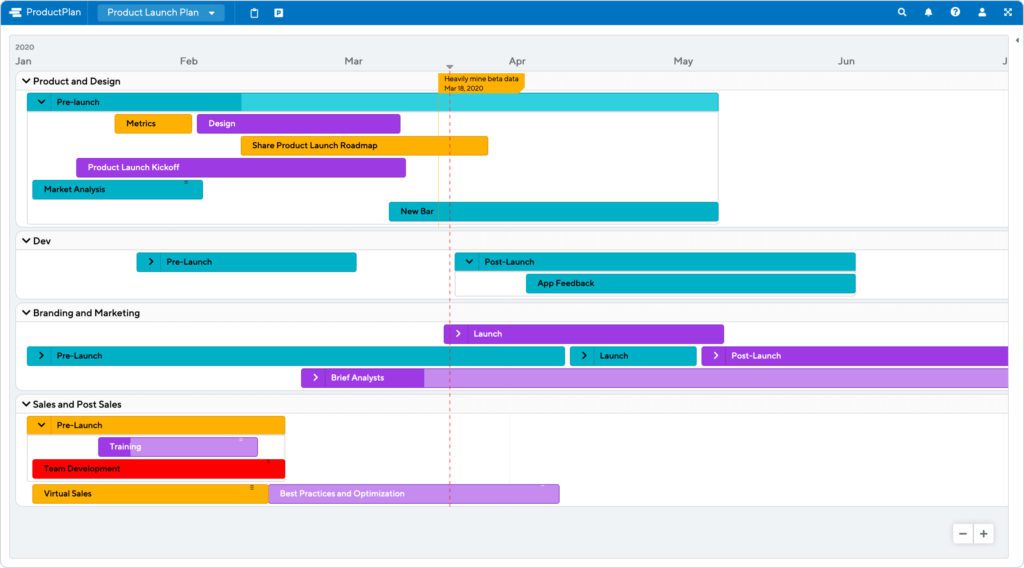In 2021, PepsiCo introduced Evolve, a new protein shake. (Well, new to PepsiCo, anyway.) This was an example of a successful product launch.
That same year, Zoom added virtual backgrounds to its videoconferencing service, allowing users to present themselves on video calls as though they were seated in a high-end conference room or even sitting at the beach. This was an example of a successful feature launch.
A product launch and feature launch share several tactics and best practices. But although many of the methods overlap, successfully launching a product differs in important ways from successfully launching a new feature for a product already on the market.
We’ll discuss those key differences below, using the real-world Pepsi and Zoom launches from 2021. Then we’ll suggest some steps and best practices you can take for executing both the successful launch of your next product or feature.
First, though, let’s define our terms.
What is a Product Launch?
A product launch refers to all the coordinated steps in a company’s plan to deliver a product to the market. It involves far more than releasing the product to customers.
For example, a product launch includes pre-launch market research and messaging to the company’s target users. It also involves developing plans for user onboarding and preparing the support team to help users after the product goes live.
Learn the Anatomy of a Product Launch ➜
What is a Feature Launch?
A feature launch refers to the coordinated steps in a company’s plan to make a new feature available in its product.
Like launching a new product, a feature launch requires a lot of market research, coordination across the company, and communication with the public before the new feature becomes available in the product.
How do Product Launches vs. Feature Launches Differ?
The main differences between these launches are the goals of each (although some of the goals overlap).

The Feature Launch Example: Zoom’s Virtual Backgrounds
Now let’s review Zoom’s launch of its high-end virtual backgrounds feature, called Immersive View. How did they attempt to achieve the feature-launch goals we described above?
Reduce churn and boost retention
Zoom introduced virtual backgrounds during the COVID pandemic in 2021. At that time, millions of businesses had transitioned to remote workforces, and many had chosen Zoom as their video-meetings platform. But competition for remote-work tools had become fierce and the company needed an edge.
With its feature launch of virtual backgrounds, Zoom found a way to re-engage the attention of many of its customers. Some of those customers were no doubt talking with other videoconferencing providers. These companies aggressively targeted businesses because they knew COVID presented a unique opportunity to increase their market share.
But now many of these customers had something new and interesting in their existing Zoom application—something that made them hesitate about switching platforms. That likely increased their customer retention.
Create customer delight
The virtual background feature introduced an element of fun—something many businesses and employees were craving in their lonely, remote work environments.
Often, launching a feature for an existing product will be about adding useful functionality. Other times, your goal will be to streamline workflows or add efficiency to users’ current processes. But sometimes—and this was a great example—you’ll launch a feature in the hopes of delighting your customers.
In this case, Zoom gave its user base something to talk about, to laugh about, to share with their colleagues during video conferences. It was something… fun!
Increase average customer lifetime value (LTV)
As we noted above, introducing a cool new feature like virtual backgrounds delighted Zoom’s customers. It also likely helped the company retain those business customers longer.
In other words, launching the right feature at the right time also helped Zoom increase the average customer’s lifetime value.
Generate positive media attention
When Zoom unveiled virtual backgrounds in 2021, news outlets around the world seemed as thrilled as customers were about the new feature.
The Verge, for example, ran a story about the feature launch with this headline: “Zoom’s Immersive View could make video calls feel a bit more in-person.” CNET’s writers were equally enthused: “Zoom’s new video background has you rubbing virtual elbows.”
These business and tech journalists were stuck at home, too, and probably just as eager for something to spice up their workdays. That’s one more reason Zoom’s timing with this feature launch was perfect.
Create a competitive differentiator
By 2021, Zoom had taken the lead in remote-work videoconferencing for businesses, schools, government agencies, and other organizations. But its competitors were launching aggressive marketing campaigns—and new features of their own.
With the Immersive View backgrounds feature, Zoom created a competitive advantage over other video platforms, at least for a while. Combined with the right marketing, messaging, and media engagement, this feature launch proved to be a valuable competitive advantage during a highly competitive time.
Best Practices for Preparing a Product Launch or Feature Launch
As we pointed out earlier, you’ll want to use many of the same tactics whether you’re launching an entirely new product or a feature for an existing product. Those best practices include the following:
Prepare your messaging and value proposition
Before PepsiCo launched its Evolve product line of protein shakes, the company crafted a winning message and value proposition for the new user persona it was targeting. That message was simple: Here’s a delicious, plant-based shake to give your body the daily protein it needs to support your active and healthy lifestyle.
And when Zoom launched its Immersive View backgrounds feature, the company likewise had already laid the groundwork with smart messaging for its user base: Present yourself more professionally during your work video calls. Or, if your corporate culture allows it, have some fun and get crazy with your virtual backgrounds. Make your team laugh.
Before your product or feature launch, you’ll want to have your messaging and value proposition ready.
Get the word out
Both PepsiCo and Zoom shared the news of their upcoming product and feature launches with the right people and media outlets. They got the word out.
You’ll want to do this as well—by alerting your existing user base, engaging with your market on social media, and talking with your industry’s key journalists and influencers.
Ready your sales team
With either a product or feature launch, you’ll want your sales department ready to let their prospects and customers know when it’s available.
You’ll also want to share your team’s thoughts on messaging, product goals, and value proposition with the sales team—both to create enthusiasm among your sales reps and to help them articulate these important messages to customers.
Set KPIs to gauge whether the new product or feature is succeeding.
Finally, you’ll want to settle on a few success metrics to monitor after your product or feature launch.
These could be new customers or revenue for a product launch, for example. If you’re launching a new feature, you might choose to track reduction in churn and monitor customer reviews for a trend toward higher average ratings.
Bottom line: Whether you launch a product or a feature, you’ll need a way to measure the success of that launch.
Good luck!
One more tip: With the right native app for roadmapping, you can easily create a product launch plan roadmap. It’ll look something like this…

Learn More About Successful Product and Feature Launches
Feeling overwhelmed? Not sure how or where to start preparing for your product or feature launch?


